 Image via EBay
Image via EBayShort-lived, like many of its brethren and certainly overlooked, Blast! had some worthwhile strip content and is certainly worth a revisit. Luke Williams delves into its pages…
By the late 1980s, following the triple header of Watchmen, The Dark Knight Returns and Maus, comics were becoming acceptable, even fashionable and “hip”. Not in the way they have become acceptable now, through the influx of superheroes into the mainstream and they are seen as the testing ground for high concepts that will make more money in the cinema —
Ahem...
No, the late 1980s saw a surge in “mature“ comics. More sophisticated works, which sadly sometimes merely meant more T&A, a bit of swearing and angst. There were many fine works amongst the bandwagon jumpers and the comics that had already laid the foundations, American Flagg!, Grendel, Love & Rockets and so on.
With 2000AD maturing with its audience and comics being mentioned in all the right places by the right people, there was a short, sharp flurry of newsstand anthologies aimed at the more “discerning reader”. Leading the way was Deadline, a mix of non genre comics by young creators, music and the culture, Fleetway looked to capitalise on the so called “mature” comics’ boom, with overly worthy Crisis and the short lived hipster Revolver. Marvel UK launched short-lived fortnightly anthology Strip, with a mix of original and reprinted US and European material. This was followed up with the short lived anthology Meltdown reprinting series from their “Epic” line, although the latter, as mentioned here, was actually a means to test which release frequency worked better on the news stand for the company, rather than intending any long standing publishing commitment. (Fortnightly, it turned out, the format chosen for Overkill).
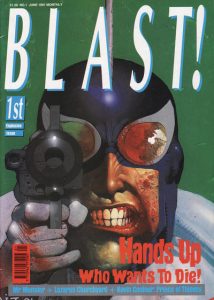 John Brown Publishing, already experiencing astonishing success with VIZ, dipped their toe into this seemingly burgeoning market with Blast! in 1991. It ran for just seven issues.
John Brown Publishing, already experiencing astonishing success with VIZ, dipped their toe into this seemingly burgeoning market with Blast! in 1991. It ran for just seven issues.
With an editorial team including such luminaries as editor Stuart Green, later to move onto the monthly incarnation of Roy of the Rovers, and Dave Elliot, comic polymath and now publisher at Atomeka, Blast! morphed from the seemingly forgotten UK comics review magazine Speakeasy.
It was conceived as a mixture of cutting edge original and reprint strip content, from both sides of the Atlantic, with Speakeasy continuing as a pullout review and culture section.
The strip content was a broad church of science fiction, crime, drama and comedy featuring established creators and some that would become very well known today.
Heralding the new magazine, “Mr. Monster” the Golden Age character resurrected by Michael T Gilbert was an all new strip drawn by art maniac Simon Bisley. “Mr. Monster” is basically an excuse for B movie madness of the titular hero battling ghouls, ghosts, zombies and werewolves. T&A, gore and, monsters, all right up the Biz’s street and playing to his strengths. What more could you want?
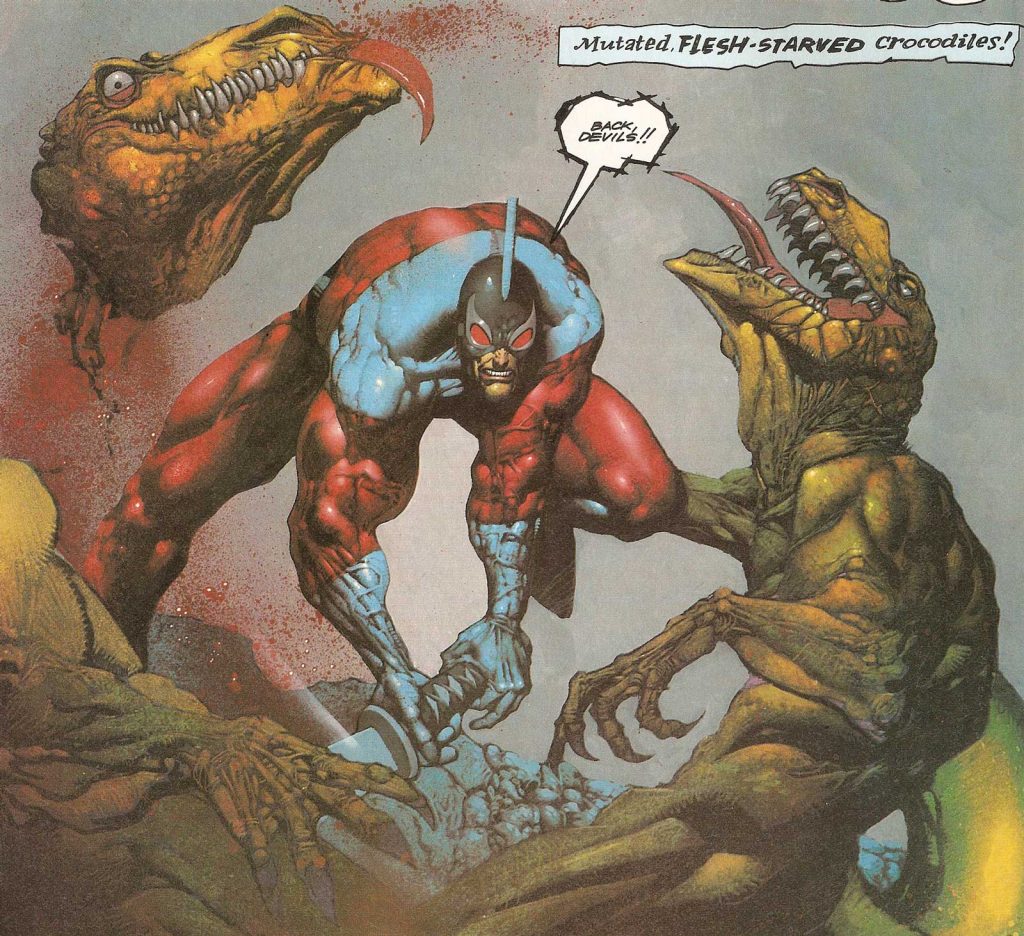
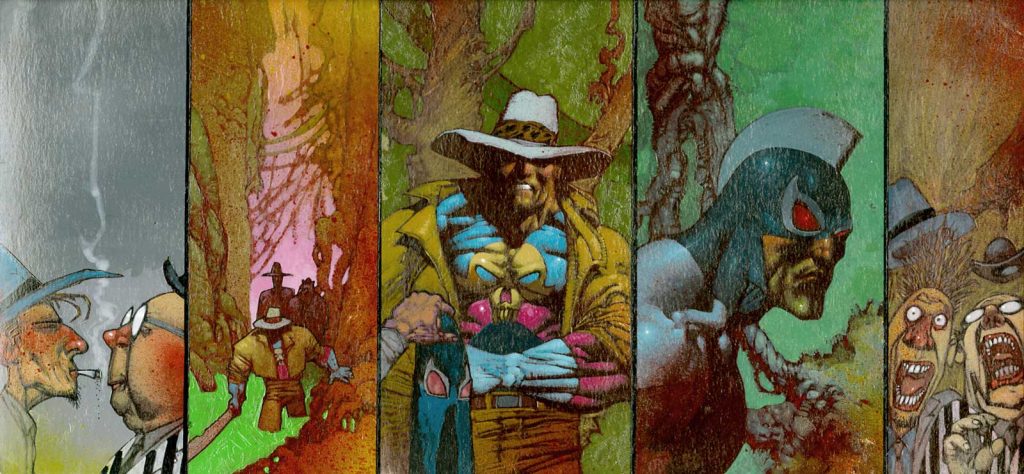 Reprints followed this new work, written and laid out by Gilbert with finished pencils and inks by William Messner-Loebs.
Reprints followed this new work, written and laid out by Gilbert with finished pencils and inks by William Messner-Loebs.
The long-lost “Axel Pressbutton” makes a one off appearance, written by the late, great Steve Moore (working under the pseudonym Pedro Henry and also known for his “Bug Hunters” work with Jerry Paris and drawn by the equally late, great Steve Dillon.
Axel is a botanophobic cyborg mercenary / bounty hunter who can only achieve sexual gratification by someone pressing the large button on his chest. He has appeared in a number of publications including the music magazine Sounds and in the legendary Warrior. This one-off is comical, violent and strangely apposite today, considering it’s a 28 year old strip.
Of the newbies, perhaps the most notable contributions were Warren Ellis and D’Israeli on “Lazarus Churchyard” drawn by D’Israeli. A science fiction tale of the 400 year-old titular character, who wanted to die, but could not. Offered a chance to end his life if he helped find a scientist who was the key to a series of mysterious deaths, Laz’ gets drawn into a web of corporate espionage that doesn’t end well. Ellis’s signature tropes are already present: tech savvy, sardonic black humour and foul mouthed chain smoking characters. D’israeli provides sublime character designs and artwork.
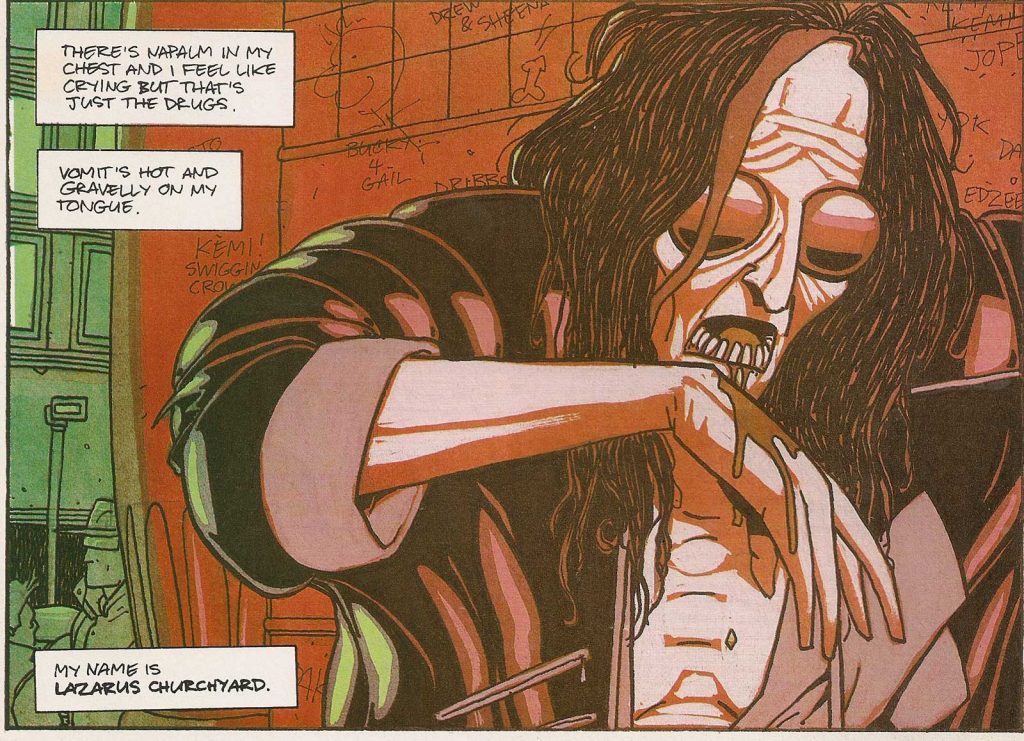
“Big Berta” written by the pseudonymous Marya Muerta (Igor Goldkind) and drawn by Yan Shimony, kind of like a sex starved “Tank Girl” in a dystopian future where everyone is quite straight laced and sex is if not banned then looked down on, and women are “sub male” bawdy and explicit it reads like Carry on Emmanuel meets Akira.
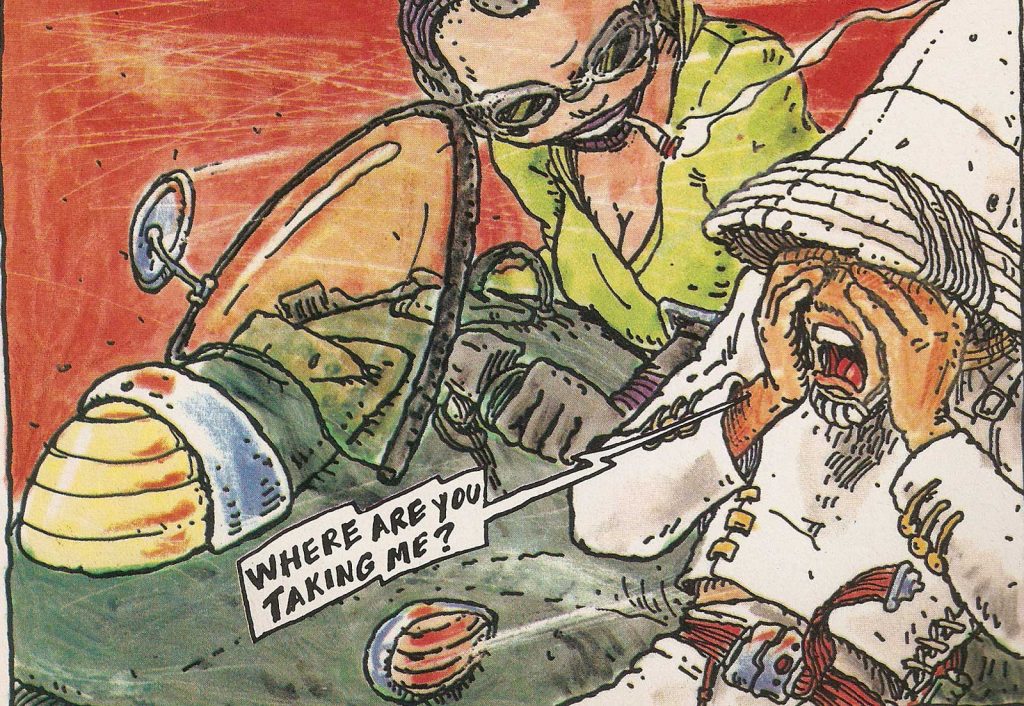
“War” by Glen Dakin, now known as a children’s author offers a satirical look at conflict via scratchy newspaper style one pagers offering some (black) comic relief.
In amongst the one offs strips there were contributions from Colin De Suinn and David Hine providing a disturbing one off involving ventriloquists and transvestites, Nick Abadzis and John Buckle’s slice of life “Martin Spoade” a one-off that was perhaps going to go somewhere but didn’t, alongside contributions from Shaky Kane, and “Dog Tag Afternoon” an almost nonsensical cyberpunk future strip by Warren Ellis and Lee Barnard.
Reprint was varied, but of high quality. Sanchez Abuli and Jordi Bernet’s masterful 1930s mob thriller Torpedo was among them, the earlier harder edged strips before the strip started to descend into farce. Short, sharp crime dramas, perfect little crime vignettes, reproduced in monochrome for much of the magazines existence after the misguided attempt at colouring the strip in Issue One.
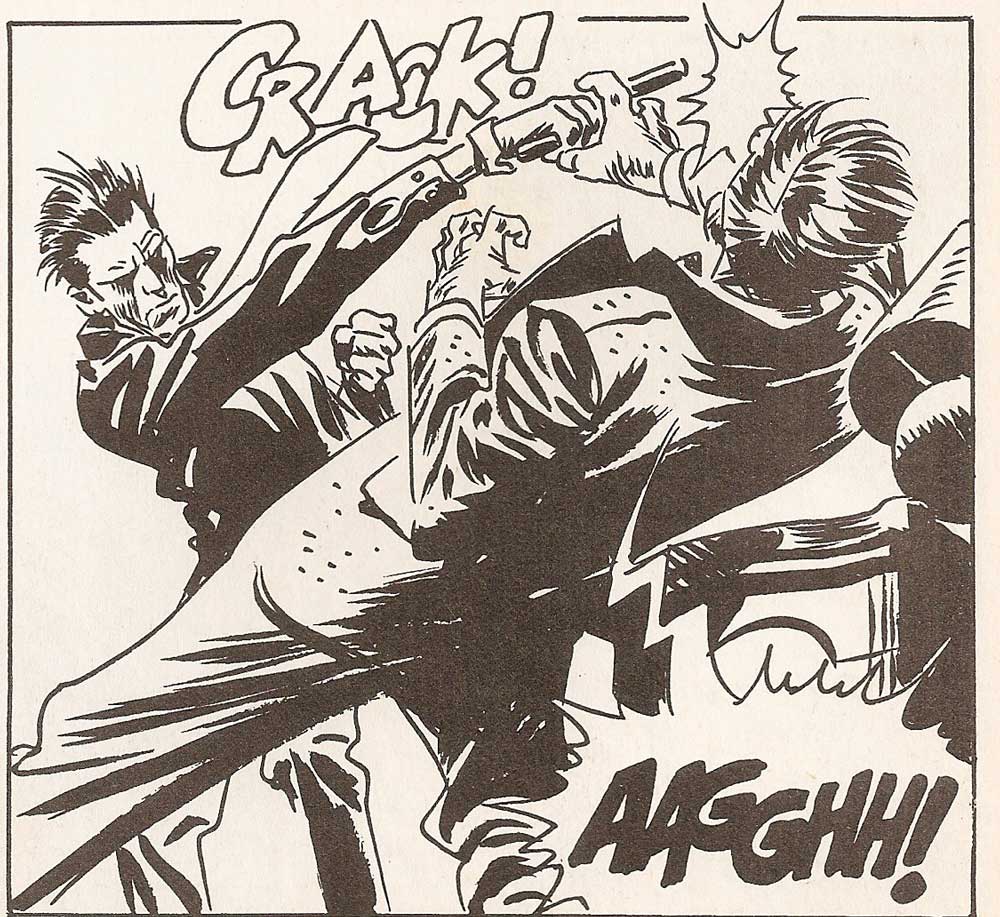
Paul Chadwick also contributes reprints of his “Concrete” strips from Dark Horse Presents. It’s the story of a gentle, studious writer, whose brain had been implanted in an almost indestructible body of well….. concrete. Despite his bulky frame, with a touch of unrequited love and a strong supporting cast most of Concrete’s strips revolve around topics as diverse as the environment, celebrity and insecurity.

Peter Bagge had a number of strips running in the magazine, his very early “Junior” strips and “The Bradleys”. Snide, violent and cruder than his later work, “The Bradleys” makes The Simpsons look like the The Brady Bunch, and for all its lack of sophistication its great. Whereas “Junior“ is dark, nihilistic and riddled with self hate.
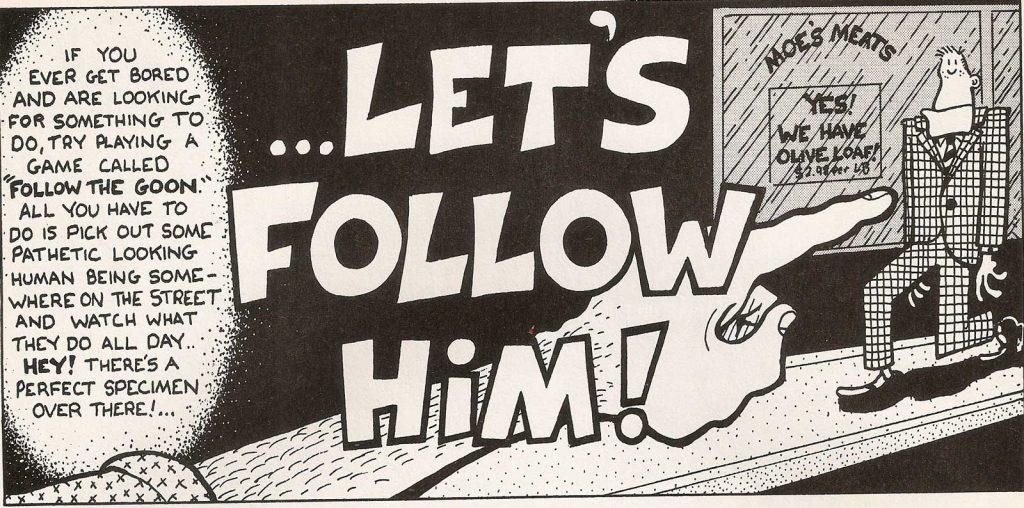
The transplant recipient of a dog’s heart, Charles Burns’ “Dog Boy”, is big on surreal visuals, beautifully inked but unsettling, uneasy art. Retro 1950’s style tale of a boy meets girl, except this boy likes sniffing butts and digging up bones.
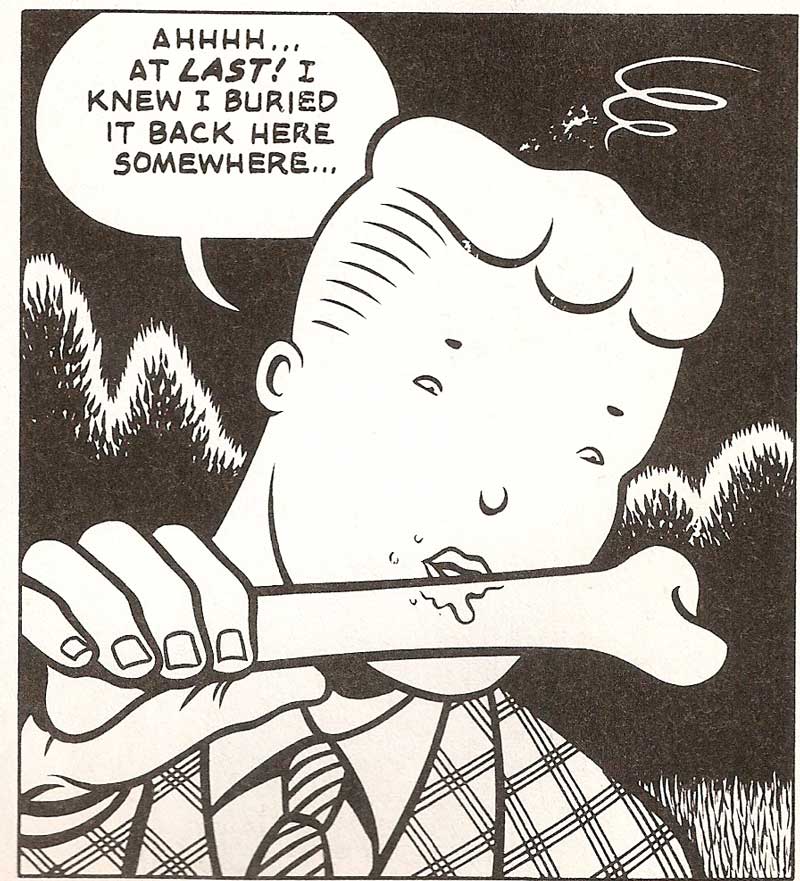
By the time Issue Six rolled around, the Speakeasy pull-out had been abandoned, and articles, including work from Warren Ellis and interviews with JG Ballard and Terry Pratchett, and reviews were now scattered throughout the magazine. It was beginning to read like a more conventional Deadline, and we didn’t need two of those.
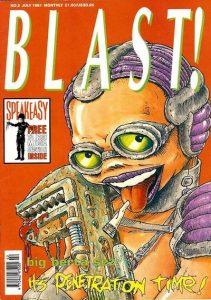 Seven was the final issue, just as there was an injection of new material Gordon Rennie and Martin Edmond with the riotous “White Trash“, the further adventures of Elvis Presley with Axl Rose lookalike Dean in tow, in a bullet ridden, explosive road trip across the American Midwest. Gordon and Woodrow Phoenix also began a series that predated League of Extraordinary Gentlemen, the uber meta “Sherlock Holmes and The Curious Case Of The Vanishing Villain”, mashing up Sherlock Holmes, and Jekyll & Hyde.
Seven was the final issue, just as there was an injection of new material Gordon Rennie and Martin Edmond with the riotous “White Trash“, the further adventures of Elvis Presley with Axl Rose lookalike Dean in tow, in a bullet ridden, explosive road trip across the American Midwest. Gordon and Woodrow Phoenix also began a series that predated League of Extraordinary Gentlemen, the uber meta “Sherlock Holmes and The Curious Case Of The Vanishing Villain”, mashing up Sherlock Holmes, and Jekyll & Hyde.
 When Dave Elliot left John Brown, the publisher immediately pulled the plug on the title. “I think it wasn’t going to be another VIZ so he stopped it,” Dave told downthetubes. “As far as I know it was in profit. But he didn’t do much to promote it.
When Dave Elliot left John Brown, the publisher immediately pulled the plug on the title. “I think it wasn’t going to be another VIZ so he stopped it,” Dave told downthetubes. “As far as I know it was in profit. But he didn’t do much to promote it.
“I bought out the rights for ‘Lazarus Churchyard’ and ‘White Trash’ and published the completed strips at Tundra.”
The remaining “Lazarus Churchyard” strips, “White Trash” and “Sherlock” all eventually appeared in their own titles via Kevin Eastman’s Tundra. (White Trash was collected more recently by Titan Books back in 2015).
The problem with Blast! was that some of the material was too “niche” for most, and those that did like it had already bought the reprint material in their original printings from their local comic shop.
Blast! is the forgotten hipster news stand comic. It wasn’t as preachy or as earnest as Crisis, it wasn’t trying to be as knowingly hip as Revolver, but its lack of identity, and, for the publisher, failure to appeal to a more mainstream audience was, perhaps, its undoing.
Luke Williams
[amazon_link asins=’1781168210,178108176X,1782760652,B073ZP7L24,B00NGIZX64′ template=’ProductCarousel’ store=’downthetubes’ marketplace=’UK’ link_id=’4ed99519-5cc6-468b-952a-cdf82f50e273′]
One of many guest posts for downthetubes.
Categories: 2000AD, British Comics, Creating Comics, downthetubes Comics News, downthetubes News
 In Memoriam: Comic Artist, Writer, Inspiration: Paul Neary
In Memoriam: Comic Artist, Writer, Inspiration: Paul Neary  International comic community pays tribute to 2000AD and Look-In artist John M. Burns
International comic community pays tribute to 2000AD and Look-In artist John M. Burns  Fundraiser in memory of comic artist and writer Ian Gibson smashes target
Fundraiser in memory of comic artist and writer Ian Gibson smashes target
Not forgotten here…
It didn’t help that by 1991, the tank was getting pretty empty for these sorts of anthologies. Deadline and Crisis started in 1988 and weren’t setting the world on fire.
It’s weird that Warrior had finally foundered in 1985, proving that no matter how good the material, it was impossible to make money off this sort of anthology magazine. Yet a slew of them followed a few years later and… none of them did particularly well.
As good as Blast! might have been — personally I thought characters-pointing-guns-at-the readers covers always reeked of desperation — I could never forgive it for supplanting Speakeasy.